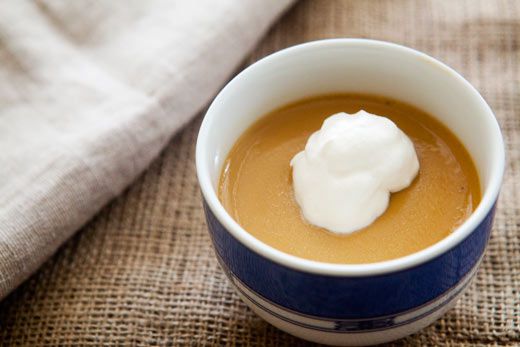Rich and creamy old-fashioned butterscotch pudding made with butter, brown sugar, cream, milk and egg yolk.
You asked for it, you got it. Please say hello to guest author Garrett McCord as he shares this excellent butterscotch pudding recipe with you. ~ Elise
When I was doing an internship at Grange Restaurant, the most popular dessert on the menu was butterscotch pudding. People just loved it, and once it came off the menu there was such demand for its return that we would inevitably put it up again.
Anyway, I didn’t get it. What was so damn great about butterscotch? At one point I decided to grab one of the puddings from the cart and see what the fuss was about.
Guys, now I get it.
This butterscotch pudding perfectly captures that combination of brown sugar and butter that is so nostalgic and utterly satisfying. While the recipe makes four, you’ll have a hard time not eating them all yourself. In addition, the recipe is simple, affordable, and uses very common ingredients.
It’s one of those delightful little recipes that takes no effort but makes you a dessert god in the eyes of whoever you serve it to. Serve with freshly whipped cream and, if you like it extra special, butterscotch biscuits.
Butterscotch pudding
ingredients
-
2 tablespoons unsalted butter
-
1 1/2 cups dark brown sugar
-
1/2 teaspoon kosher salt
-
1 1/4 cup heavy whipping cream
-
3/4 cup whole milk
-
3 egg yolks
-
1 1/2 tablespoons vanilla extract
method
-
Preheat the oven, heat the water, prepare the ramekins:
Preheat oven to 325°F and bring a kettle of water to a boil. Prepare four ramekins or ovenproof bowls and a large casserole dish.
-
Prepare the butterscotch base with butter, sugar, salt, cream and milk:
Melt the butter in a saucepan. Once melted, add the brown sugar and salt and stir until well combined.
Add the cream and milk to the sugar mixture. Heat until steaming and small, pinhole-sized bubbles appear on side of saucepan and ingredients combine (about 170°F to 180°F). It should not boil or even simmer as this will cause the milk to scald or curdle. Remove from the stove immediately.
-
Tempering the yolk:
Slowly pour the heated sugar-milk mixture into the yolks in a thin stream, whisking constantly so the yolks are tempered by the warm mixture, but not cooked.
-
Add vanilla and strain mixture through a sieve:
Stir in vanilla extract. Pour through a fine sieve to catch any cooked egg pieces.
-
Pour the mass into moulds, prepare the water bath:
Scoop the mixture evenly into the molds. Place the ramekins in a heavy-bottomed pan and pour the hot water into the pan until the water comes halfway up the sides of the ramekins.
Lightly tent the entire pan (not each individual casserole dish) with some aerated foil. The foil can easily be shirred on two opposite sides, it should not be airtight.
-
Bake:
Bake at 325°F for 45-50 minutes. Be sure to rotate the pan halfway through cooking. When you shake them, they jiggle like jelly. It shouldn’t ripple or move like a liquid when you shake it. Don’t worry as they will straighten up after they cool down. Chill in the refrigerator for a few hours before serving.
Links:
Butterscotch Pudding, once removed by Michael Procopio
Butterscotch Pudding on the Stove by David Lebovitz




